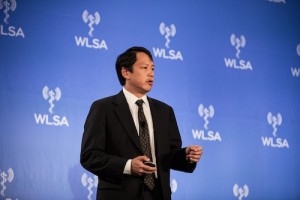
Photo Credit: Paul Savage Photography
By Padma Nagappan
Getting care providers to communicate with each other and share patient data with a network of care givers can go a long way towards helping reduce costs and improve patient care and healthcare, Dr. Theodore Chan, who is working on the San Diego Beacon Community project, stated during his remarks at WLSA last week.
The Beacon Community initiative is a partnership between health care providers, hospitals, clinics, emergency medical services and health care organizations that taps IT to share information in real time, giving physicians timely access to data when patients visit multiple care facilities, among other benefits.
The pilot program is the only one in the state of California, and along with 17 other projects around the country, has funding of about $250 million in ARRA funds. The projects will help foster health information exchanges (HIEs), EHR expansion and adoption, telemedicine and e-care, among other innovations.
The San Diego Beacon will focus on outcomes for cardiovascular and cerebrovascular disease targets, childhood immunization rates and hospital readmissions. It is the only Beacon project headed by emergency room physicians and will focus specifically on EMS and emergency medicine.
Chan is the medical director of the emergency department at the University of California, San Diego Health System. He said emergency physicians need access to a patient's medical history and medication lists which are critical but often not available to acute management. Health IT and HIEs have the potential to address this problem and improve patient care in emergency rooms.
The conundrum with health IT, Chan said, is that it simultaneously offers too little information and too much information. He explained the contradiction with an example. A recent patient he saw came to his ER and mentioned she'd just had a baby two days before. When asked why she'd come to the ER instead of going back to the maternity department, she responded that she thought she'd just check her condition out at the ER.
"Well, I didn't have the other hospital's files on her, so I had to treat her from scratch. There's a one in four chance that some one will be readmitted to a hospital within 30 days and they may come to a new hospital next time and we end up doing a lot more tests than we need to -- but we don't have any of their previous info," Chan said.
Under the aegis of the Beacon project, Chan's team looked at all the ER visits in San Diego and found that quite a few people had been to more than one ER. And the frequent flyers had had more than 6 visits a year to ERs.
"This is why we need to be able to share information."
The Beacon health exchange coordinates information with EMS, area hospitals, the San Diego Veteran's Administration, the department of defense and assorted clinics.
"We're in the process of setting up a messaging system for all Navy dependents so they can actually ping us when they head to a hospital -- if we know ahead of time they're coming, we can share information and do what we can to reduce costs overall," Chan said.
The San Diego exchange has also set up a system where emergency medical technicians can do an EKG on the field, send it to their EMR vendor, and it will get back to the hospital even before the EMS ambulance arrives with the patient experiencing a cardiac event. "If they headed to UCSD, we'd have the EKG data. If the ambulance found it quicker to go to Scripps or Kaiser, they'd have that info too," Chan said. "Also with this information from the EKG, if it looks bad, we can arrange to have a cardiac cath team on hand, so we can improve care and increase the speed of care too, while reducing costs."
On the flip side, with too much information, the problem is with getting a data dump. Doctors look up patients' charts and often find that there are just notes upon notes. One of Chan's colleagues told him, "if I have to do three clicks, I'm not doing it, I have to have the info in one click."
The other part of this problem is that with so many CRM vendors, each with their own portals, this requires care givers to have different IDs and passwords for each portal and keep track of it as well.
The Beacon program partnered with Geneva Healthcare to consolidate all the data into a single click and streamline it. Chan demonstrated it for the convergence audience. When some one logs onto the screen now, they can get all the patient information they need on one screen. When they want particulars, they hover the mouse over sub-topics which then pop up on the same screen page with additional details.
"It's a pathway that coalesces all the information and makes it usable and actionable," Chan said.
















